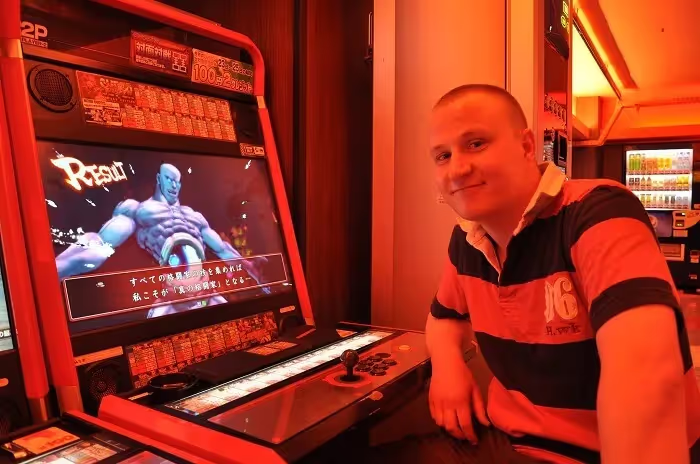I’ve landed on an uncharted planet. My ship is broken. I need to survive, but there’s a mystery that I must get to the bottom of. Oh, and it’s a rogue-lite too. The tropes are all too real in Journey To The Savage Planet and, in its opening moments, the game revels in it.
As its faux-panicked facade falls and its idiosyncratic, almost sarcastic, humour comes to the fore I start to think that I might like this game. Surrounded by the pop of bright colours, the car-salesman-like tones of Martin Tweed blaring from a TV in wonderful FMV, it’s clear that Typhoon Studios want to do something different — a ridiculous retro-modern take on what is otherwise a story that has been told far too many times already.
It’s an auspicious start for Journey to the Savage Planet. The FMV introduction from Martin Tweed sets the scene well. My character is one of many participants in the Kindred Aerospace Pioneer Program. The fourth best interstellar exploration company, Kindred, is looking for a new place for humanity to inhabit. From the few chance glimpses, it seems we’ve botched Earth for good and it’s time to move on. Unfortunately, the planet that I have landed on wasn’t as uninhabited as Tweed and Kindred thought (I suppose that’s why they’re only fourth best). There also seems to be some kind of strange transmission coming from the centre of an alien-looking spire in the centre. My choice is simple, check it out or get the hell out of there. Either way, I’m going to have to brave the outside.

Taking place over three distinct, lush, colourful biomes, the titular Savage Planet is filled with all sorts of alien lifeforms. Some are predators and some are prey. All of them look like they’ve come from the mind of a particularly imaginative child. In fact, the whole game has this wonderfully tactile, plasticky, look to it. Each biome has the feeling of an expansive playset, with a number of routes to work your way across, species to find and fight and areas to uncover. It promotes exploration whilst keeping enough stuff off limits until you have the right upgrade.
That Metroidvania-style curiosity is combined with the trial and error nature of a rogue-lite and everything about it clicks. Traversal is especially fun, especially as you unlock more upgrades to allow you to glide and swing through the environment. Each new tool or piece of equipment is fun to use and allow for varied combat or increased exploration in the open world. Some, like the explosive Bombegranates or essential Grapple Seeds, are more useful than others but you’ll find your own favourite combos to suit your style as you go.
Adapting quickly is important too. Despite being bright and toyetic, there’s still plenty to contend with early on. I don’t want to say that I died a lot but, well, I died a lot. Death is handled with the same kind of acerbic charm as everything else in this game, and doesn’t feel too punishing either. Respawning as a clone back at your ship, heading out to retrieve your (always conveniently placed) loot and going again. Maybe you’ll even choose to bury your old self as a mark of respect?

A few upgrades and some more orange goo consumed (orange goo = health and stamina, of course) to the tune of some more genuinely funny chatter from my disembodied AI sidekick and I felt like I could take on anything. Until I couldn’t. From the beginning combat had been stiff, with the acts of both aiming and firing your one pistol feeling at odds with a game that generally wanted you to shoot things. After all, there was a constant need to collect resources or fend off predators.
Approaching the final third of the game, Journey To The Savage Planet simply asks too much of you — of its own systems. This is not a game that caters for chaotic boss battles and tight platforming and yet, somehow, that became a requirement. In the end, the core gameplay loop of explore, die, pick up your loot, retry, just stopped being fun, the silly voice lines that accompanied my reemergence started to annoy instead of amuse, and the ‘edgy’ adverts for gross products started to sound even more like Rick and Morty outtakes. Even the game’s solid yet simple narrative had sort of fallen by the wayside.

Whilst it still managed to force a smile out of me every so often and I still wanted to see how this bumbling exploration played out, my early fondness for the game had ground to a halt by the time I finished it. At just over ten hours, Journey To The Savage Planet certainly hadn’t outstayed its welcome. In fact, its restraint and focus, despite there being plenty to probe and research, was refreshing. I just wish it had been able to maintain a solid trajectory throughout that time.
A pliable, rich rainbow-hued adventure at its best, Journey To The Savage Planet was unfortunately a small, stumbling step, as opposed to the giant leap that the game demonstrated it could be at the outset. The things that made this game unique, the things that made me smile in the beginning, faded away amongst a glut of frustration and repetition. Anyone who plays this will be able to see how big Typhoon Studios were dreaming. They shot for the moon and, whilst they got close, Journey to the Savage Planet doesn’t quite stick the landing.
You can subscribe to Jump Chat Roll on your favourite podcast players including:
Let us know in the comments if you enjoyed this podcast, and if there are any topics you'd like to hear us tackle in future episodes!

.avif)


